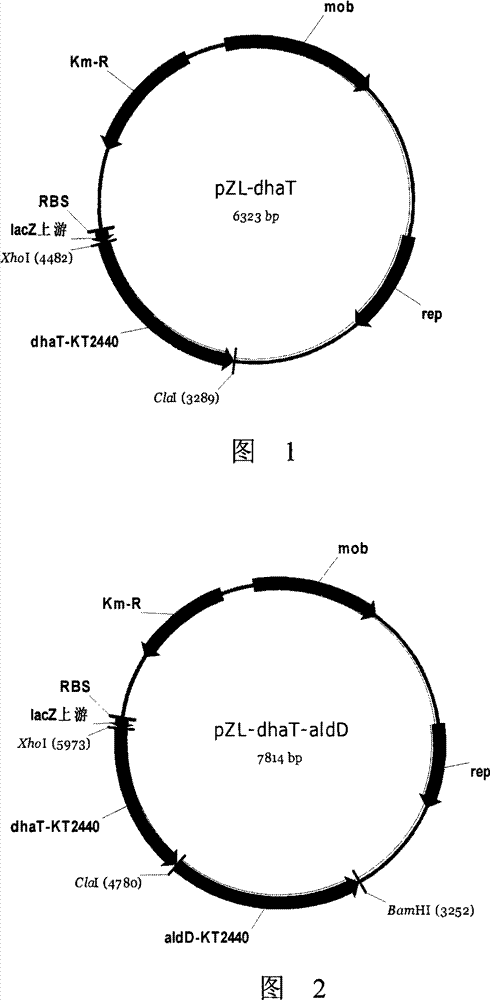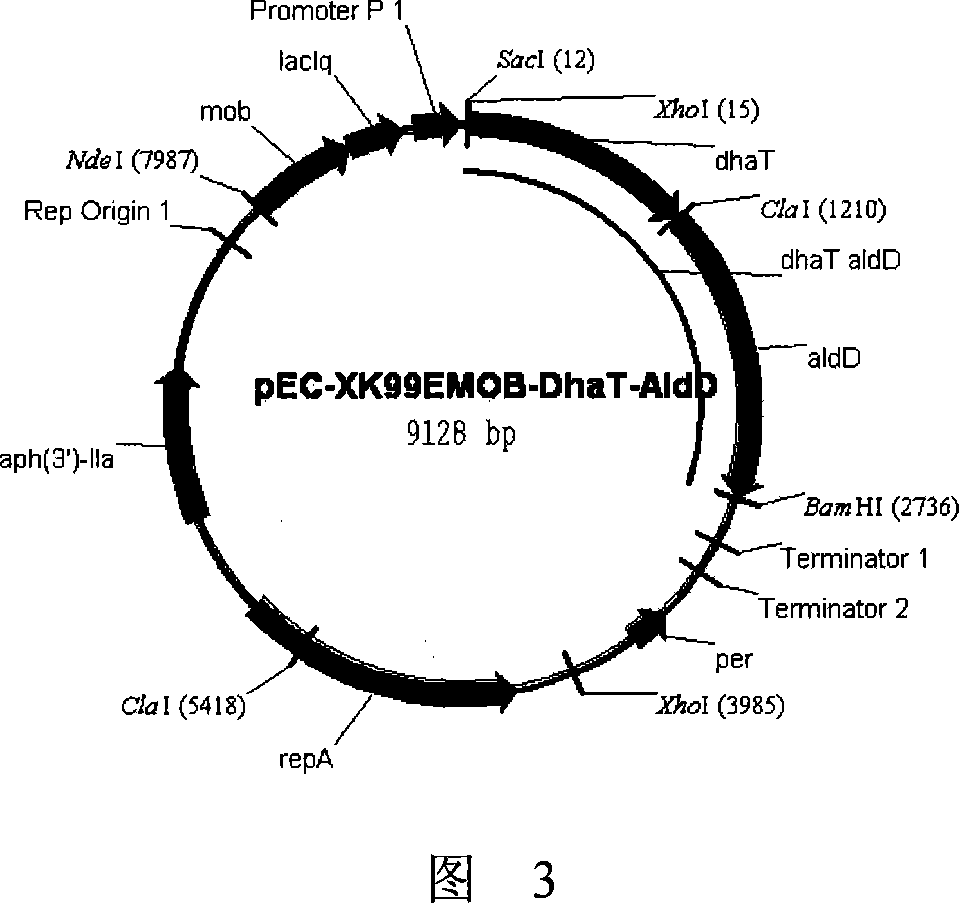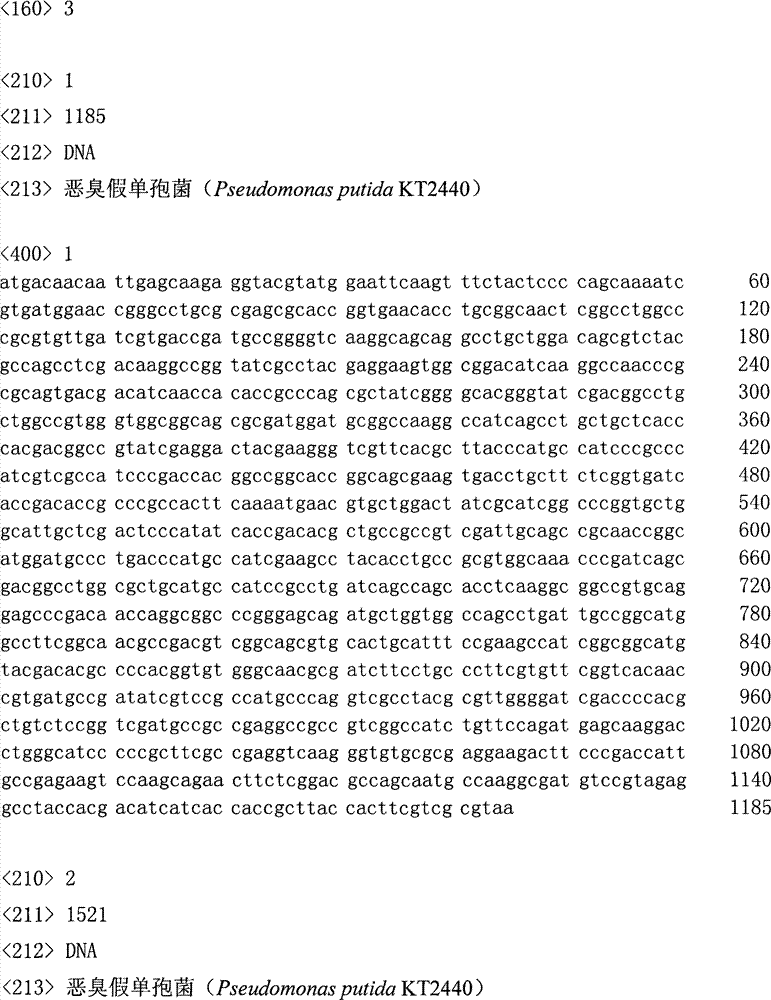Method for producing 3-hydracrylic acid
A technology of hydroxypropionic acid and microorganisms, which is applied in the field of production of 3-hydroxypropionic acid, and can solve problems such as difficulty in large-scale production, difficulty in large-scale production and the like
- Summary
- Abstract
- Description
- Claims
- Application Information
AI Technical Summary
Problems solved by technology
Method used
Image
Examples
Embodiment 1
[0023] Embodiment 1, wild-type Pseudomonas putida KT2440 utilizes 1,3-propanediol to produce 3HP
[0024] Strain: Pseudomonas putida KT2440 (DSMZ, catalog number: DSM6125 )
[0025] The medium is composed of substances with the following concentrations: 10g / L peptone, 5g / L yeast extract, 10g / L sodium chloride, 10g / L 1,3-propanediol, and the pH value is 6.7-7.2. The solvent of the culture medium is water. Sterilize at 121°C for 20 minutes.
[0026] Culture method: Pseudomonas putida KT2440 (DSMZ, commodity catalog number: DSM6125) is connected 2 rings with inoculation loop under aseptic condition in the 500ml Erlenmeyer flask that 50ml above-mentioned culture medium is housed, at 13mm radius of rotation, rotating speed is 225rpm / min Incubate for 48 hours at 30°C in a shaker. The experiment was repeated three times, each with 10 bottles.
[0027] Processing and testing: the fermentation broth was centrifuged to remove bacteria, and 3ml of the supernatant was placed in an est...
Embodiment 2
[0036] Embodiment 2, wild-type Pseudomonas putida KT2442 utilizes 1,3-propanediol to produce 3HP
[0037] Bacteria: Pseudomonas putida KT2442 (Tsinghua University) (Franklin, F.C.H., Bagdasarian, M., Bagdasarian, M.M.and Timmis, K.N., 1981. Molecular and functional analysis of the TOL plasma pWW0 from Pseudomonas putida and cloning of genes for the entire romatire meta-cleavage pathway. Proceedings of the National Academy of Sciences USA 78, pp.7458-7462)
[0038] The medium is composed of substances with the following concentrations: 10g / L peptone, 5g / L yeast extract, 10g / L sodium chloride, 10g / L 1,3-propanediol, and the pH value is 6.7-7.2. The solvent of the culture medium is water. Sterilize at 121°C for 20 minutes.
[0039] Culture method: Put Pseudomonas putida KT2442 under sterile conditions into 2 rings with an inoculation loop in a 500ml Erlenmeyer flask containing 50ml of the above-mentioned medium, and culture it in a shaker with a rotation radius of 13mm and a ro...
Embodiment 3
[0041] Embodiment 3, wild-type Aeromonas hydrophila, ATCC7966 utilizes 1,3-propanediol to produce 3HP
[0042] Strain: Aeromonas hydrophila ATCC7966 (American Type Type Collection Center ATCC, catalog number: ATCC7966)
[0043] The medium is composed of substances with the following concentrations: 10g / L peptone, 5g / L yeast extract, 10g / L sodium chloride, 10g / L 1,3-propanediol, and the pH value is 6.7-7.2. The solvent of the culture medium is water. Sterilize at 121°C for 20 minutes.
[0044] Culture method: Put Aeromonas hydrophila, ATCC7966 (ATCC, catalog number: ATCC7966) under aseptic conditions in a 500ml Erlenmeyer flask containing 50ml of the above-mentioned medium with an inoculation loop, and rotate it at 13mm Incubate at 30° C. for 48 hours in a shaker with a radius and rotation speed of 225 rpm / min. The experiment was repeated three times, each with 10 bottles.
[0045] Processing and testing: the fermentation broth was centrifuged to remove bacteria, and 3ml of...
PUM
 Login to View More
Login to View More Abstract
Description
Claims
Application Information
 Login to View More
Login to View More - R&D
- Intellectual Property
- Life Sciences
- Materials
- Tech Scout
- Unparalleled Data Quality
- Higher Quality Content
- 60% Fewer Hallucinations
Browse by: Latest US Patents, China's latest patents, Technical Efficacy Thesaurus, Application Domain, Technology Topic, Popular Technical Reports.
© 2025 PatSnap. All rights reserved.Legal|Privacy policy|Modern Slavery Act Transparency Statement|Sitemap|About US| Contact US: help@patsnap.com



